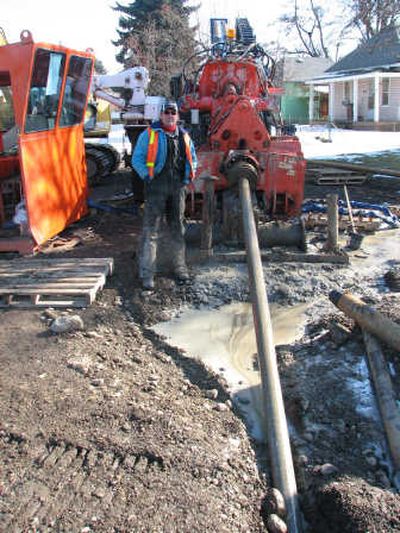River’s dumpy past haunts modern-day construction

Down through history, rivers have been used as garbage disposals and trash bins. Even our mighty Spokane River has suffered indignities. The location of these travesties occurring along the river are not all known. People are quick to forget trash and garbage.
J.R. Reynolds and Keith Kinnan from Camas Valley, Ore., found an old dump site on the Spokane River. The hard way.
Kinnan owns a company that drills holes in the ground. Last fall, the city of Spokane hired Kinnan Engineering to drill a tunnel big enough for a sewer pipe to be installed crossing under the Spokane River just east of Gonzaga University.
The drilling equipment was set up near the river bank at the end of the East 1500 block of Boone Avenue. The tunnel’s target was a sewer pipe running along the river on the other side, 380 feet away, in the backyard of the old Holy Names Academy which is now the Academy Retirement Community on North Superior Street next to Mission Park.
Kinnan’s crew had a 2-foot “window” on the other side of the river, where their drill bit must break through in order to attach the new sewer line to the existing sewer line behind the Academy.
The drilling involved an electronically guided drill bit which was monitored from above, on a boat that was fixed to a line that traveled across the river over the route where the sewer line was to be installed. Thirty-foot lengths of slightly flexible (up to 15 degrees) drill pipe would be attached consecutively so the drill bit would push through a tunnel that would curve back up on the other side of the river to meet the other sewer pipe.
The drilling started last fall. The first 320 feet of tunneling was a breeze. The job, which was expected to be done in a month, was ahead of schedule.
Then about 60 feet from the far bank, the drill bit began to deflect off course. The bit was retracted some distance and then returned to the proper angle. It deflected off course again. And again.
The crew decided something unusual was buried in the river bottom.
They retracted the drill bit several times and examined the materials that came back out the hole each time. Old bottles. Pieces of iron stoves. Utensils. Even car parts.
While examining the odd materials, the crew was visited by a senior citizen who was the job’s “Sidewalk Superintendent.” He had been watching their salvage operation. The old gentleman informed the drilling crew that the river bank on the other side had been a dump when he was a young lad living in this same neighborhood. This was before Upriver Dam and the other dams maintained a more constant river flow. The man said the river “would pretty much dry up” at that dump site in the summers back then.
That information was of little comfort to Kinnan’s drilling crew who had to work outside in this winter, one of Spokane’s worst in decades. The junk deflected the drill bit over and over. Day after day. Things from iron grates to whole cars delayed the drilling crew for months.
Finally, at 11:09 a.m. on Feb. 19, the drill bit broke through on the other side of the Spokane River. The crew had hit a bull’s-eye inside the 2-foot window. It wasn’t the Boston Big Dig. Nor the Chunnel. But those projects probably didn’t have to drill through a lot of garbage and trash.
As the crew tore down their drilling equipment to leave for new jobs in new places, I ask them not to speak of this sad episode to people in distant lands. Spokane’s got an environmental reputation to uphold. The crew assured me that this would be our own little secret.
I would accept a small cash award from the Chamber of Commerce.